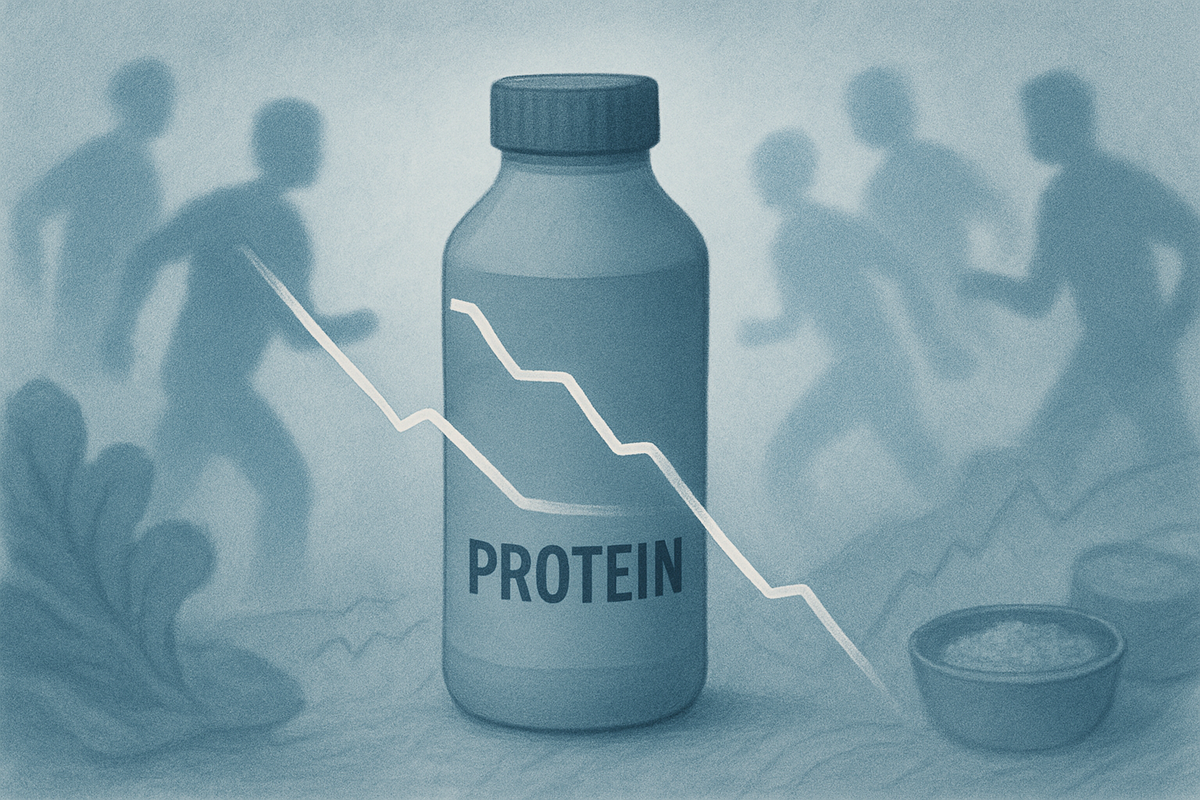
St. Louis, MO – November 19, 2025 – BellRing Brands (NYSE: BRBR), a prominent player in the convenient nutrition sector, sent ripples through the market yesterday by announcing a significant recalibration of its long-term financial growth targets. The company, known for its popular Premier Protein and Dymatize brands, now projects an annual net sales growth of 7% to 9% and aims to maintain Adjusted EBITDA margins between 18% and 20% of net sales. This revised outlook signals a more cautious stance, primarily attributed to an increasingly competitive landscape and persistent pressures from commodity prices, factors that are reshaping the broader nutrition and food industry.
The announcement, made on November 18, 2025, comes after a period of heightened market uncertainty for BellRing Brands, which had previously withdrawn its fourth-quarter sales outlook and delayed guidance for fiscal year 2026. This move suggests that the underlying challenges have solidified into a more enduring trend, prompting the company to adjust its strategic trajectory. For investors and industry observers, the revised targets underscore the evolving dynamics within the health and wellness market, where strong consumer demand for protein and healthy options is now met with formidable operational hurdles and fierce rivalry.
BellRing's Strategic Shift: Navigating a Turbulent Market
BellRing Brands' decision to temper its long-term growth ambitions stems from a confluence of specific market forces. The company explicitly cited intensified competition, particularly within crucial retail channels such as club stores, where its Premier Protein (NYSE: BRBR) products have historically enjoyed strong positioning. New entrants and expanded production capacities from existing players are creating a more crowded and aggressive market, making it challenging for BellRing to sustain previous growth rates without significant strategic adjustments. Financial analysts, including those at Morgan Stanley (NYSE: MS), have highlighted the potential for market share erosion as a direct consequence of this burgeoning competition.
Adding to the competitive pressures are the relentless challenges posed by commodity price volatility. BellRing Brands has been grappling with significant input cost inflation, particularly for protein, a core ingredient in its product lines. These protein cost headwinds are expected to persist well into fiscal year 2026, exacerbated by tariff-related cost increases. While the company has previously implemented price increases to mitigate these rising costs, there's a delicate balance to strike between maintaining profitability and remaining competitive on price. The combination of higher input costs and increased promotional spending, often a necessity in a competitive environment, is squeezing profit margins and demanding more efficient operational strategies.
The timeline leading to this announcement suggests a gradual acknowledgment of these headwinds. The earlier withdrawal of its fourth-quarter sales outlook and the delay in providing fiscal year 2026 guidance were early indicators that BellRing Brands was reassessing its market position and operational environment. This latest revision of long-term targets represents a formalization of that reassessment, providing a clearer, albeit more conservative, roadmap for the company's future. Key stakeholders include BellRing's management team, its board of directors, and its institutional and retail investors, all of whom will be closely scrutinizing how the company plans to navigate this challenging period.
The Shifting Sands of the Nutrition Industry: Winners and Losers
BellRing Brands' revised outlook is poised to create both winners and losers within the competitive nutrition and food industry. For BellRing Brands (NYSE: BRBR) itself, the immediate impact could be a period of investor caution as the market digests the more modest growth projections. The company will likely need to double down on innovation, brand differentiation, and cost management to protect its market share and profitability. Its established brands, Premier Protein and Dymatize, still hold significant consumer loyalty, but sustaining that in a cutthroat environment will require strategic agility. The focus will shift from aggressive top-line expansion to efficient execution and margin preservation.
Competitors in the ready-to-drink protein and nutritional supplement space stand to either gain or face similar pressures. Companies with strong supply chain resilience, diverse product portfolios, or a more favorable cost structure for key ingredients might find opportunities to capture market share where BellRing cedes ground. Smaller, agile brands that can quickly adapt to consumer trends and manage input costs effectively could emerge as significant challengers. Conversely, other major players relying heavily on similar protein inputs or operating in the same competitive channels might soon face similar pressures on their own growth targets, potentially leading to a broader industry slowdown in projected growth.
Retailers, particularly club stores like Costco (NASDAQ: COST) and Sam's Club (NYSE: WMT), which are key distribution channels for BellRing, will continue to benefit from the overall consumer demand for health and wellness products. However, the increased competition among brands could give retailers more leverage in pricing and promotional agreements, potentially impacting manufacturers' margins. Ingredient suppliers, on the other hand, might face fluctuating demand or pricing pressures from manufacturers if commodity costs remain high, forcing companies like BellRing to seek more competitive sourcing or reformulate products. Ultimately, the companies that can best adapt to persistent inflation, supply chain volatility, and shifting consumer preferences while maintaining competitive pricing will be the ones to thrive in this evolving landscape.
Broader Implications for the Food and Beverage Sector
BellRing Brands' recalibrated growth targets are not an isolated event but rather a symptom of broader trends sweeping across the food and beverage industry. The heightened competition reflects a maturing market where consumer demand for protein-rich, convenient nutrition has attracted a multitude of players, from established food giants to innovative startups. This saturation means that differentiation, brand loyalty, and efficient supply chains are more critical than ever. The event underscores the industry-wide challenge of balancing robust consumer interest in health and wellness with the operational realities of intense market rivalry and volatile input costs.
The persistent impact of commodity prices is a significant ripple effect across the entire sector. While BellRing specifically cited protein costs, the broader food industry continues to grapple with inflation in grains, oils, and other agricultural products, often driven by climate change, geopolitical instability, and lingering supply chain disruptions. This ongoing volatility forces companies to make difficult decisions regarding pricing, product formulation, and hedging strategies. It also puts pressure on the entire supply chain, from farmers and processors to manufacturers and retailers, as everyone attempts to absorb or pass on rising expenses. The situation for BellRing could foreshadow similar announcements from other food and beverage companies struggling with these same macro-economic headwinds.
Historically, periods of high commodity price volatility have often led to consolidation within the food industry, as larger players leverage their scale to secure better pricing or smaller, less resilient companies struggle to survive. It also prompts innovation in ingredient sourcing and the development of alternative, more cost-effective formulations. Regulatory bodies are increasingly focused on food security and sustainable supply chains, which, while not directly tied to BellRing's growth targets, add another layer of complexity and cost to operations. BellRing's move serves as a stark reminder that even in high-growth segments like convenient nutrition, external economic forces and competitive dynamics can significantly alter a company's trajectory and outlook.
What Comes Next: Navigating the New Normal
In the short term, BellRing Brands (NYSE: BRBR) will likely focus on reinforcing its market position through targeted marketing, product innovation within its Premier Protein and Dymatize lines, and aggressive cost management initiatives. Investors will be watching for detailed plans on how the company intends to maintain its Adjusted EBITDA margins in the face of ongoing commodity pressures and increased promotional spending. Strategic pivots could include optimizing its supply chain for greater resilience, exploring new sourcing partners, or even considering M&A opportunities to gain scale or acquire complementary brands that offer synergistic cost benefits.
Looking further ahead, the long-term possibilities for BellRing Brands hinge on its ability to adapt to what appears to be a "new normal" of moderated growth expectations within the convenient nutrition space. This might involve a greater emphasis on international expansion, diversification into adjacent health and wellness categories, or leveraging its brand equity to introduce new product formats. The market opportunities that may emerge include capitalizing on specific consumer sub-segments within the health and wellness trend, such as plant-based protein alternatives or personalized nutrition, which could offer higher margins or less intense competition.
However, significant challenges remain, including the continued threat of new competitors, the unpredictable nature of global commodity markets, and the potential for shifts in consumer preferences. Potential scenarios range from BellRing successfully stabilizing its market share and profitability within the revised growth targets, to a more difficult environment where margin erosion continues, necessitating more drastic strategic overhauls. What is clear is that the company will need to demonstrate exceptional agility and strategic foresight to navigate these turbulent waters, with its ability to innovate and control costs being paramount to its future success.
A Comprehensive Wrap-Up: Adapting to Evolving Market Realities
BellRing Brands' decision to cool its long-term growth targets marks a significant moment for the company and provides a crucial barometer for the broader nutrition and food industry. The key takeaways from this event are clear: even high-growth sectors are not immune to the dual pressures of intensified competition and persistent commodity price inflation. For BellRing, this means a strategic shift from aggressive expansion to a more focused approach on operational efficiency, brand strength, and sustainable profitability within a more realistic growth framework.
Moving forward, the market will be closely assessing how BellRing Brands (NYSE: BRBR) executes its revised strategy. The ability to innovate within its core Premier Protein and Dymatize brands, manage input costs effectively, and maintain strong relationships with key retail partners will be critical. This event underscores the need for all public companies in the food and beverage sector to build resilient supply chains, develop robust hedging strategies against commodity volatility, and continuously differentiate their offerings in a crowded marketplace.
Investors should watch for BellRing's upcoming earnings calls for more granular details on cost-saving initiatives, new product pipelines, and market share trends. Beyond BellRing, this announcement serves as a signal for the entire industry: the era of seemingly boundless growth in convenient nutrition may be giving way to a more challenging, yet potentially more sustainable, period where strategic discipline and adaptability will determine long-term success. The lasting impact of this recalibration will be felt not only in BellRing's financial statements but also in the strategic adjustments made by its peers as they too navigate the evolving realities of consumer demand, competitive intensity, and global economic pressures.
This content is intended for informational purposes only and is not financial advice





